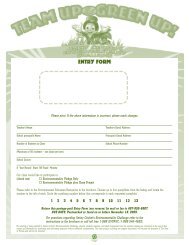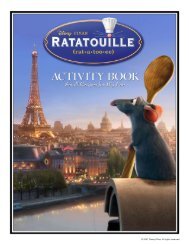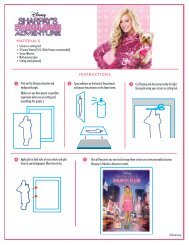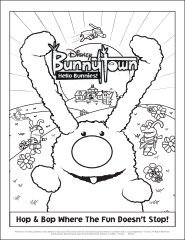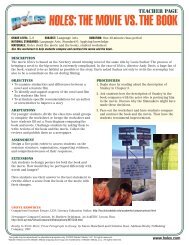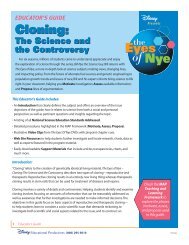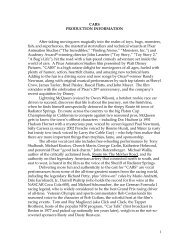introduction - Disney
introduction - Disney
introduction - Disney
Create successful ePaper yourself
Turn your PDF publications into a flip-book with our unique Google optimized e-Paper software.
11<br />
The Land / People Connection<br />
One major theme of America’s Heart & Soul is the connection between<br />
the land and the people—how one influences the other. In his book that<br />
accompanies the film, director Louis Schwartzberg states, “The circular<br />
relationship between people and the land has always intrigued me. I think that<br />
people shape the land and the land shapes the people’s psyche.”<br />
While this idea is not exclusive to America, it does have a long tradition<br />
in this country that can be traced back to the Native Americans. Distribute<br />
copies of Handout 3: The Navajo Origin Legend. (This is the story of<br />
how the Navajo were created.) After students read and annotate the handout,<br />
begin a discussion of what a reader can infer about the values of the<br />
Navajo: how does the Navajo Origin Legend reveal a deep reverence for what<br />
comes from nature as well as the spiritual connection between nature and man?<br />
What does the text suggest about the relationship between natural phenomena<br />
and human life?<br />
Next begin a discussion of how America’s Heart & Soul explores a similar con-<br />
nection: What people in the film reveal a deep connection with the land? How<br />
does the film explore the ways in which the<br />
land has shaped these people’s personalities<br />
and attitudes? Students might discuss their<br />
own sense of connection to the land as found<br />
in their everyday lives or when they visit majestic<br />
places like the ones shown in the film.<br />
Here is a partial list of characters whose<br />
egments in the film reveal strong land /people<br />
connections:<br />
Roudy Roudebush<br />
(horse wrangler)<br />
Marc and Ann Savoy (Cajun musicians)<br />
Minnie Yancy (rug weaver)<br />
George Woodard (dairy farmer)<br />
Ed Holt (grape grower)<br />
Charles Jimmie, Sr. (Tinigit Elder)<br />
Erik Weihenmayer (blind climber)<br />
Of course, students can also discuss the<br />
ways in which characters such as bike<br />
messenger John “Yac” Yacobellis or the<br />
Reverend Cecil Williams reveal their<br />
connections to more urban landscapes.<br />
Ultimately, you may have students<br />
compose short pieces (in prose or verse)<br />
about their own connections to the land<br />
itself.<br />
Our life is frittered away detail.Simplicity, simplicity,<br />
by<br />
simplicity! I say, let your fairs be as two or three, and not a<br />
afhundred<br />
or a thousand;<br />
instead of a million count<br />
half a dozen, and keep your<br />
accounts on your thumb-nail.<br />
S i m p l i f y , s i m p l i f y .<br />
Instead of three meals<br />
a day, if it be necessary<br />
eat but one; instead of a<br />
hundred dishes, five; and<br />
reduce other things in<br />
proportion.<br />
. Simplify, Simplify<br />
In 1845, a twenty-eight-year-old former teacher—Henry David Thoreau—moved into a small cabin<br />
that he built with his own hands on the outskirts of Concord, Massachusetts. For two years he lived<br />
in relative isolation, growing his own food, exploring the natural world and writing in his journals.<br />
1854 saw the publication of his record of this period, Walden or Life in the Woods. Thoreau’s book<br />
is a record of his trials and triumphs while attempting to be wholly self-sufficient; Walden also<br />
explores the discoveries Thoreau made about human contentment and the ways in which materialism<br />
can corrupt the human sprit.<br />
Distribute copies of Handout 4: Simplify, Simplify and allow students some time to silently read<br />
and annotate the passage. Then begin a discussion of Thoreau’s opinions of American life. While<br />
he wrote these words over 150 years ago, many of them still ring true today. What kind of life does<br />
Thoreau advocate here? What does he really mean when he urges the reader to “keep your accounts<br />
on your thumb-nail” or to only eat one meal a day? Do you agree with his objections to the speed at<br />
which we live our lives? What are some adverse effects of “living too fast?” According to Thoreau,<br />
what would a more slowly-paced life allow us to achieve?<br />
To relate Walden to America’s Heart & Soul, ask students to first identify characters who seem to be<br />
living their lives according to Thoreau’s command, “Simplify, simplify.” Then ask students to<br />
discuss the ways in which these characters are living lives not “frittered away by detail” and what<br />
value and fulfillment they have found in “simplicity.” (Note that “simplicity” here has no negative<br />
connotations, as in the term “simple-minded.”) Ultimately, you may want to have students list the<br />
ways in which their own lives are “frittered away by detail” and then the ways in which a dose of<br />
“simplicity” may allow them to focus on what is truly important.<br />
12




